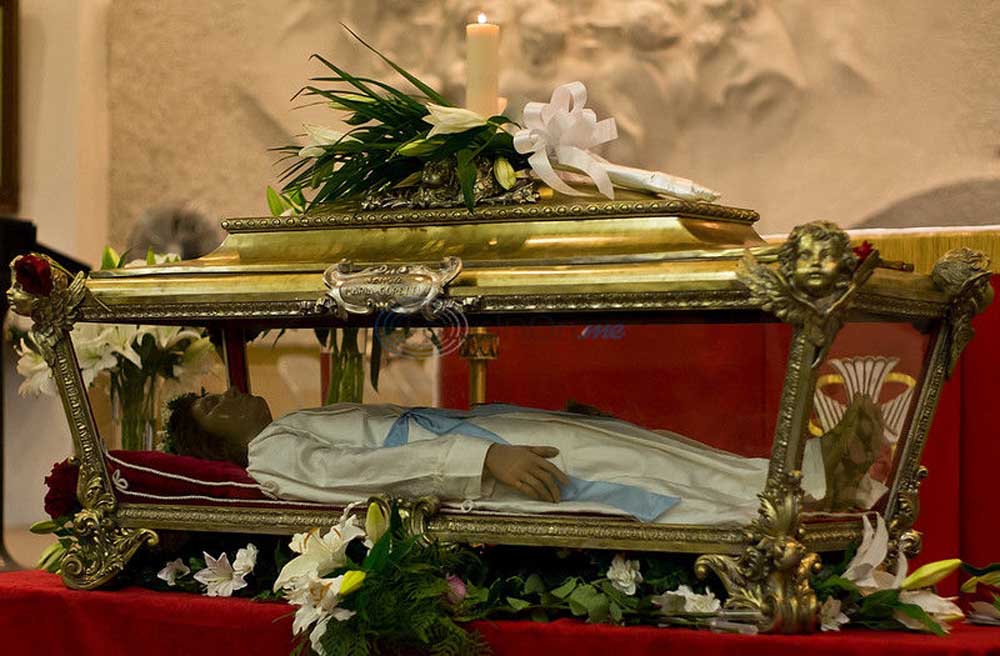Relics of youngest canonized saint to be in Tyler on Monday
Published 10:47 pm Friday, October 30, 2015

- The relics of St. Maria Goretti, the youngest canonized saint in the Catholic Church, will be in Tyler on Monday as part of a nationwide tour to promote the upcoming Holy Year of Mercy. Courtesy
East Texans will have a once in a lifetime opportunity to pray and reflect before a Catholic Saint known for her heart of mercy when the relics of St. Maria Goretti come to Tyler on Monday.
The East Texas stop is one of three in the state – Houston and Dallas are the other two – and about 40 around the country.
Trending
The tour is a part of an effort to promote the Holy Year of Mercy, which Pope Francis declared for Dec. 8, 2015 through Nov. 20, 2016.
Universally known as the Patroness of Purity, St. Maria is also known as the Patroness of Mercy and the Little Saint of Great Mercy.
For this reason, the Church selected her remains for the tour to promote the Holy Year of Mercy.
Q: Who is St. Maria Goretti?
A: St. Maria Goretti is the youngest canonized Saint in the Catholic Church. She died in 1902 when she was 11. Born into poverty in Italy, her father died when she was 9 and she was responsible for raising five siblings while her mother worked. In addition, she cleaned for two neighbors.
Trending
Q: How did she die?
A: One of the neighbors she worked for, a man named Alessandro Serenelli, repeatedly made sexual advances toward her for several months and threatened her if she didn’t comply. One day, he attempted to rape her. Although she fought him off, he stabbed her multiple times and she died the next day because of her wounds.
Q: Why is she known as the Patroness of Mercy?
A: Her last words were, “I forgive Alessandro Serenelli … and I want him with me in heaven forever.” She reportedly appeared to Serenelli during his prison sentence and forgave him. Because of that he felt sorry for his crime and from that point on, he is said to have lived a beautiful and converted life of holiness, eventually becoming a Franciscan lay brother.
Q: Has St. Maria been involved in miracles?
A: Maria is known as a wonder-worker. She has intervened with the Lord to produce countless miracles. Of all the Saints (more than 160) whose relics the Rev. Carlos Martins, Director of Treasures of the Church, ministers with, Maria is the one who by far has produced the most miracles.
Q: What is a Saint?
A: The Catholic Church teaches that the saints (lowercase s) are all those who are in heaven because they followed God’s commands on earth and died in his friendship. In an ancient tradition, the Catholic Church formally declares Saints (capital S) through a process called canonization in which the Pope formally recognizes a Catholic to be united with God in heaven based on their life of heroic virtue. The Church holds that these Saints can pray to God on behalf of the living and are worthy of public and universal respect as models for Christians to follow.
Q: What are relics?
A: Relics are items associated with the Saints’ earthly lives, usually their physical remains or items they used in their daily lives. The Catholic Church classifies relics into three categories. First-class relics are the bones of the Saints or other body parts, like a lock of hair. The instruments of the Lord’s passion such pieces of the true cross are also first class relics. Second-class relics are items used by the Saints, like their clothing or a prayer book. Third class relics are items touched to a first- or second-class relic.
Q: Why are relics so special?
A: Since the time of the Apostles, Christians have considered the relics of the Saints as one of their greatest treasures. In the same way people today might treasure something associated with a deceased friend or family member, the Catholic Church guards the Saints’ mortal remains because they are associated with people who lived holy lives and are in God’s presence in heaven.
Q: Why do Catholics pray to Saints?
A: Christians do not believe the relics are magical or helpful in a superstitious way. Rather, honoring relics of the Saints is a profession of belief in several doctrines of the faith. Because Catholics believe in eternal life for people who have been obedient to Christ and witnesses to the Gospel on Earth, they can ask those in heaven to pray for them just as they ask their neighbor or a fellow church member to pray for them. Coming before the relics of a Saint to pray is an opportunity to be physically close to someone who they believe to be perfectly righteous because they have been crowned with glory in heaven, and the Bible says that the prayers of the righteous are very powerful.
Q: What is going to happen during St. Maria’s visit?
A: St. Maria’s body will be brought into the Cathedral early Monday morning. From 9 a.m. Monday until 1 a.m. Tuesday, her physical remains, which are enclosed in a wax figure that resembles how she appeared in life, will be on display and anyone can come by the Cathedral of the Immaculate Conception to pray. The only interruption will be at 7 p.m. when Bishop Joseph Strickland will celebrate Mass at the Cathedral.
Q: How can people participate in this visit?
A: Nothing is required and nothing is expected for those who wish to participate. All people of good will whether Catholic or not are invited to come into the church and spend a few minutes or a few hours in quiet prayer and reflection. Each person will receive two prayer cards, one of St. Maria and one of Alessandro Serenelli, her repentant killer. The St. Maria prayer cards have been previously touched to her sacred relics, which makes them a third-class relic. Because of Saint Maria’s particular example, this could be a chance to pray about any heartaches, wounds, misunderstandings and troubles that have come about because of damaged or broken relationships with others.
Sources: Diocese of Tyler communications director Peyton Low and websites for the Diocese of Tyler, Tour of the Major Relics of St. Maria Goretti and United States Conference of Catholic Bishops
Twitter: @TMTEmily
Online
Visit www.dioceseoftyler.org/goretti or www.mariagoretti.com to learn more about St. Maria Goretti and her Christian witness.






